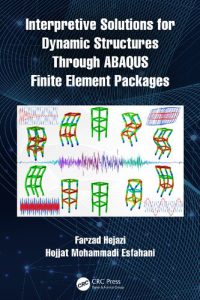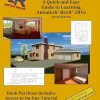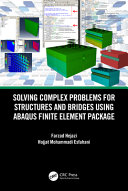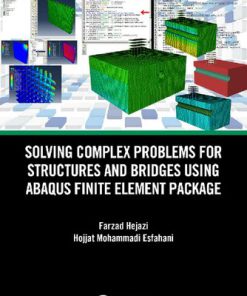Interpretive Solutions for Dynamic Structures Through ABAQUS Finite Element Packages 1st Edition by Farzad Hejazi 9781000518894 1000518892
$50.00 Original price was: $50.00.$25.00Current price is: $25.00.
Interpretive Solutions for Dynamic Structures Through ABAQUS Finite Element Packages 1st Edition Farzad Hejazi – Ebook Instant Download/Delivery ISBN(s): 9781000518894, 1000518892

Product details:
- ISBN 10:1000518892
- ISBN 13:9781000518894
- Author::Farzad Hejazi
Interpretive Solutions for Dynamic Structures Through ABAQUS Finite Element Packages
Table contents:
Chapter 1 Development of Subroutines for ABAQUS Software
1.1 Introduction
1.2 Problem Description
1.3 Objectives
1.4 Developing a UMAT Subroutine
1.5 Modeling
1.5.1 Parts Module
1.5.2 Property Module
1.5.2.1 Material Properties
1.5.2.2 Section Properties
1.5.2.3 Section Assignment
1.5.3 Assembly Module
1.5.4 Step Module
1.5.4.1 Implicit Dynamics
1.5.4.2 Explicit Dynamics
1.5.5 Required Output
1.5.6 Interaction Module
1.5.7 Load Module
1.5.8 Mesh Module
1.6 Analysis: Job Module
1.7 Analysis Results
Chapter 2 Evaluate Performance of Steel Wall in Structures Subjected to Cyclic Load
2.1 Introduction
2.2 Problem Description
2.3 Objectives
2.4 Modeling
2.4.1 Part Module
2.4.1.1 Create a New Model Database
2.4.1.2 Create Parts
2.4.1.3 Define an I Shape with Dimensions
2.4.1.4 Create Partition
2.4.2 Property Module
2.4.2.1 Material Properties
2.4.2.2 Section Properties (Type, Thickness, and Material Assignment)
2.4.2.3 Section Assignment
2.4.3 Assembly Module
2.4.3.1 Assemble Part Instances into the Model
2.4.4 Step Module
2.4.4.1 Create an Analysis Step: Step 1
2.4.5 Interaction Module
2.4.5.1 Tie Constraint
2.4.6 Load Module
2.4.7 Mesh Module
2.4.7.1 Mesh: Seed the Part (50 mm Elements)
2.4.7.2 Assign an ABAQUS Element Type
2.4.7.3 Seed and Mesh the Model
2.4.7.4 Verify Mesh
2.5 Analysis: Job Module
2.5.1 Create an Analysis Job: Job-1
2.5.2 Monitor Solution in Progress
2.6 Visualization Module
2.6.1 View the Results of the Analysis
2.6.2 Visualization/Results Module
Chapter 3 Performance of Reinforced-Concrete Frame with Embedded CFRP Rod under Cyclic Load
3.1 Introduction
3.2 Problem Description
3.2.1 Problem Statement
3.2.1.1 Material Properties
3.3 Objectives
3.4 Modeling
3.4.1 Part Module
3.4.1.1 Create a New Model Database
3.4.1.2 Create a New Model Database and a New Part
3.4.1.3 Define a Rectangle with Dimensions
3.4.1.4 Define Section of the Rebars Section with Dimensions
3.4.2 Property Module
3.4.2.1 Material Properties
3.4.2.2 Section Properties
3.4.2.3 Section Assignment
3.4.3 Mesh Module
3.4.3.1 Mesh
3.4.4 Assembly Module
3.4.4.1 Assemble Part Instances into the Model
3.4.5 Interaction Module
3.4.5.1 Tie Constraint
3.4.5.2 Embedded Region Constraint
3.4.5.3 Create an Embedded Region Constraint
3.4.6 Step Module
3.4.6.1 Create an Analysis Step: Apply Load
3.4.7 Load Condition Module
3.4.7.1 Apply Cyclic Loading to the Frame
3.5 Analysis: Job Module
3.5.1 Create an Analysis Job: Job-1
3.5.2 Monitor the Solution in Progress
3.6 Visualization Module
3.6.1 View the Results of the Analysis
3.7 Analysis Result
3.7.1 Hysteresis Results
3.7.2 Stresses in Frame
3.7.3 Total Strain in Frame
3.7.4 Plasticity Contour Plots in Frame
3.8 Discussions
Chapter 4 Behavior of Precast Beam–Column Dowel Connection under Cyclic Loads
4.1 Introduction
4.2 Problem Description
4.2.1 Geometric Properties
4.2.2 Material Properties
4.3 Objectives
4.4 Modeling
4.4.1 Part Module
4.4.1.1 Create a New Model Database
4.4.1.2 Create a New Model Database and a New Part
4.4.1.3 Define Section of the Precast Beam with Dimension
4.4.1.4 Create a Circular Hole
4.4.1.5 Create Partition
4.4.1.6 Create a New Part
4.4.1.7 Define Bottom Bar Section with Dimension
4.4.2 Property Module
4.4.2.1 Material Properties
4.4.2.2 Section Properties
4.4.2.3 Section Assignments
4.4.3 Assembly Module
4.4.4 Step Module
4.4.5 Interaction Module
4.4.5.1 Surface-to-Surface Contact Interaction
4.4.5.2 Tie Constraint
4.4.6 Load Condition Module
4.4.7 Mesh Module
4.4.8 History Output Definition
4.4.8.1 Create Sets of Nodes
4.4.8.2 History Output for the Sets
4.5 Analysis: Job Module
4.5.1 Create an Analysis Job: Job-1
4.6 Visualization Module
4.6.1 View the Results of the Analysis
4.7 Contour plots
4.8 Conclusion
Chapter 5 Simulation of the Preloaded Bolt Connection under Cyclic Loading
5.1 Introduction
5.2 Problem Description
5.3 Objectives
5.4 Modeling
5.4.1 Part Module
5.4.1.1 Modifying Parts for Use in the Connection
5.4.2 Material Properties
5.4.3 Section Properties
5.4.4 Section Assignment
5.4.5 Assembly Module
5.4.6 Meshing Module
5.4.7 Step Module
5.4.8 Interaction Module
5.4.8.1 Coupling Constraint
5.4.9 Load Module
5.4.10 Boundary Condition
5.5 Analysis: Job Module
5.6 Results
Chapter 6 Beam–Column Connection Retrofitted with CFRP Sheets Subjected to Pushover Loading
6.1 Introduction
6.2 Problem Description
6.3 Objectives
6.4 Modeling
6.4.1 Part Module
6.4.1.1 Create a New Model Database
6.4.1.2 Create a New Model Database and a New Part
6.4.1.3 Define a Rectangle with Dimensions
6.4.1.4 Extrude Solid to Create a Beam
6.4.2 Property Module
6.4.2.1 Material Properties
6.4.2.2 Section Properties
6.4.2.3 Assign Sections to Parts
6.4.3 Mesh Module
6.4.4 Assembly Module
6.4.5 Step Module
6.4.6 Interaction Module
6.4.7 Load Module
6.5 Analysis: Job Module
6.6 Visualization Module
Chapter 7 Hollow Circular Ultra-High-Performance Concrete (UHPFRC) Section under Lateral Cyclic Load
7.1 Introduction
7.2 Problem Description
7.2.1 Geometric Properties
7.3 Objectives
7.4 Modeling
7.4.1 Part Module
7.4.2 Property Module
7.4.2.1 Material Properties
7.4.2.2 Section Properties
7.4.2.3 Assigning the Defined Section to the Parts
7.4.3 Assembly Module
7.4.4 Step Module
7.4.4.1 Create an Analysis Step: Cyclic
7.4.4.2 Create an Amplitude
7.4.4.3 Create Set for Request History Output
7.4.4.4 Create Partitions for the Hollow Circular Section
7.4.5 Interaction Module
7.4.5.1 General Contact Interaction
7.4.5.2 Embedded Region Constraint
7.4.6 Load Condition Module
7.4.6.1 Apply the Cyclic Displacement as a Boundary Condition
7.4.6.2 Apply Boundary Condition to the Column Base
7.4.7 Mesh Module
7.5 Analysis: Job Module
7.6 Visualization Module
7.7 Analysis Result
Chapter 8 Modal Analysis of a Three-Story Building
8.1 Introduction
8.2 Problem Description
8.3 Objectives
8.4 Modeling
8.4.1 Part Module
8.4.1.1 Create a New Model Database
8.4.1.2 Create Part
8.4.2 Property Module
8.4.2.1 Material Properties
8.4.2.2 Section Properties
8.4.2.3 Section Assignment
8.4.3 Assembly Module
8.4.4 Step Module
8.4.5 Interaction Module
8.4.5.1 Tie Constraint
8.4.6 Load Module
8.4.7 Mesh Module
8.5 Analysis: Job Module
8.6 Visualization Module
People also search:
interpretive solutions for dynamic structures through
what is dynamic analysis of structures
types of dynamic analysis of structures
types of dynamic analysis in fea
what is dynamic analysis in fea
You may also like…
Engineering - Mechanical Engineering & Dynamics
Practical Finite Element Analysis for Mechanical Engineering First Edition Dominique Madier
Engineering - Engineering Technology
Mathematics - Numerical Analysis
Graded Finite Element Methods for Elliptic Problems in Nonsmooth Domains 1st Edition Hengguang Li
Engineering - Engineering - General & Miscellaneous
Finite Element Analysis for Design Engineers Second Edition Paul M. Kurowski
Computers - Computer Graphics & Design
Finite Element Analysis for Design Engineers 3rd Edition Paul M. Kurowski
Housekeeping & Leisure - Interior Design & Decoration












